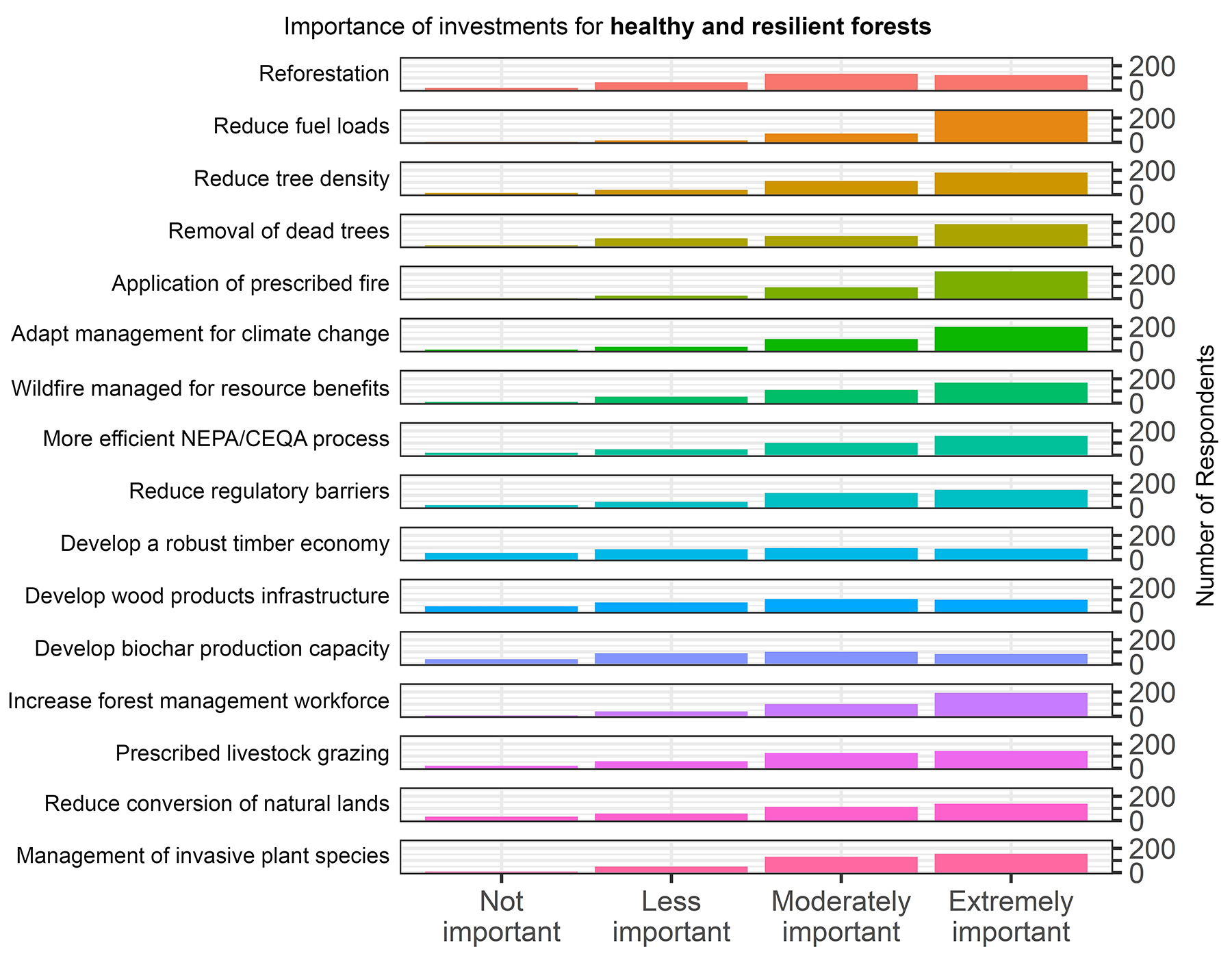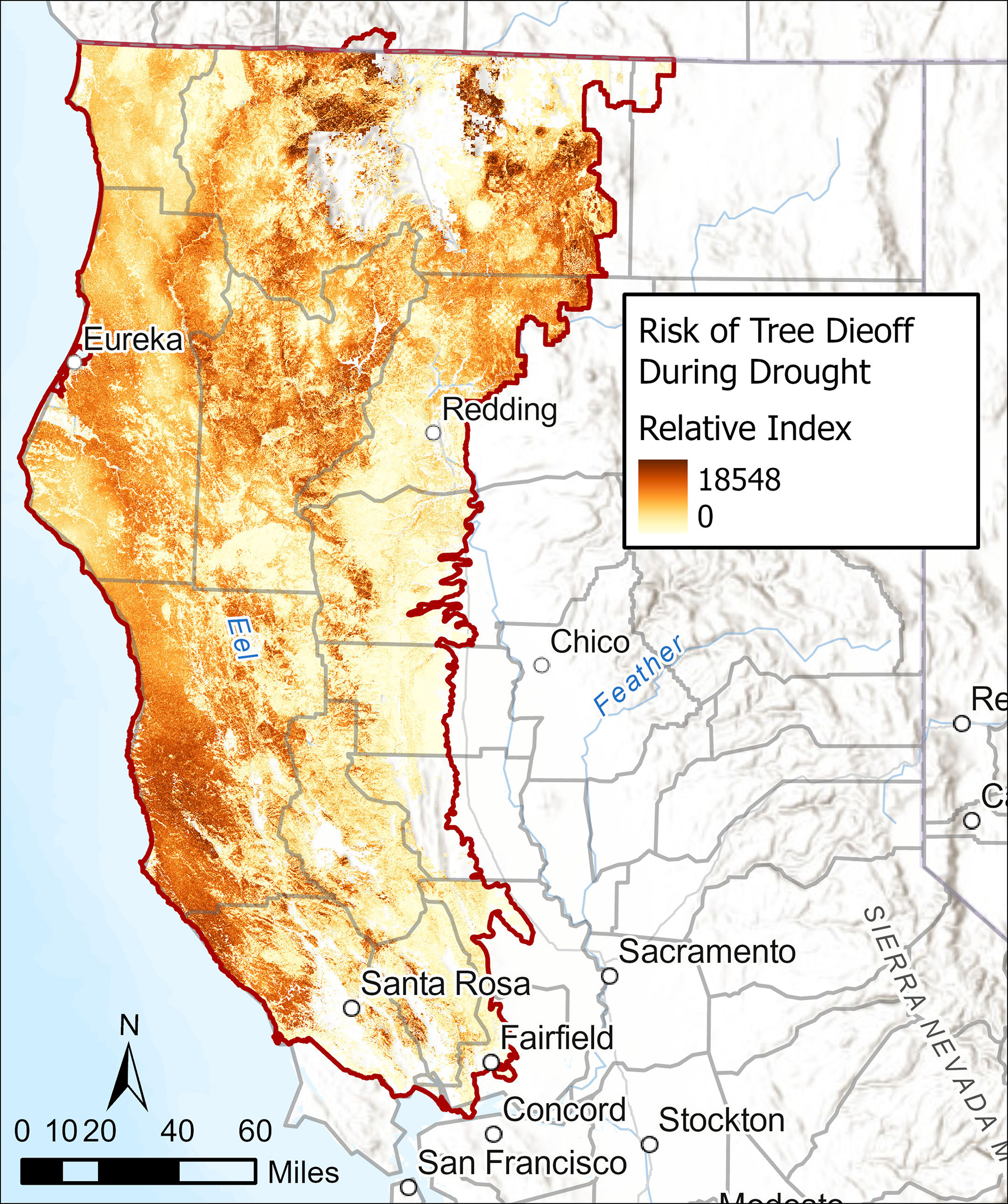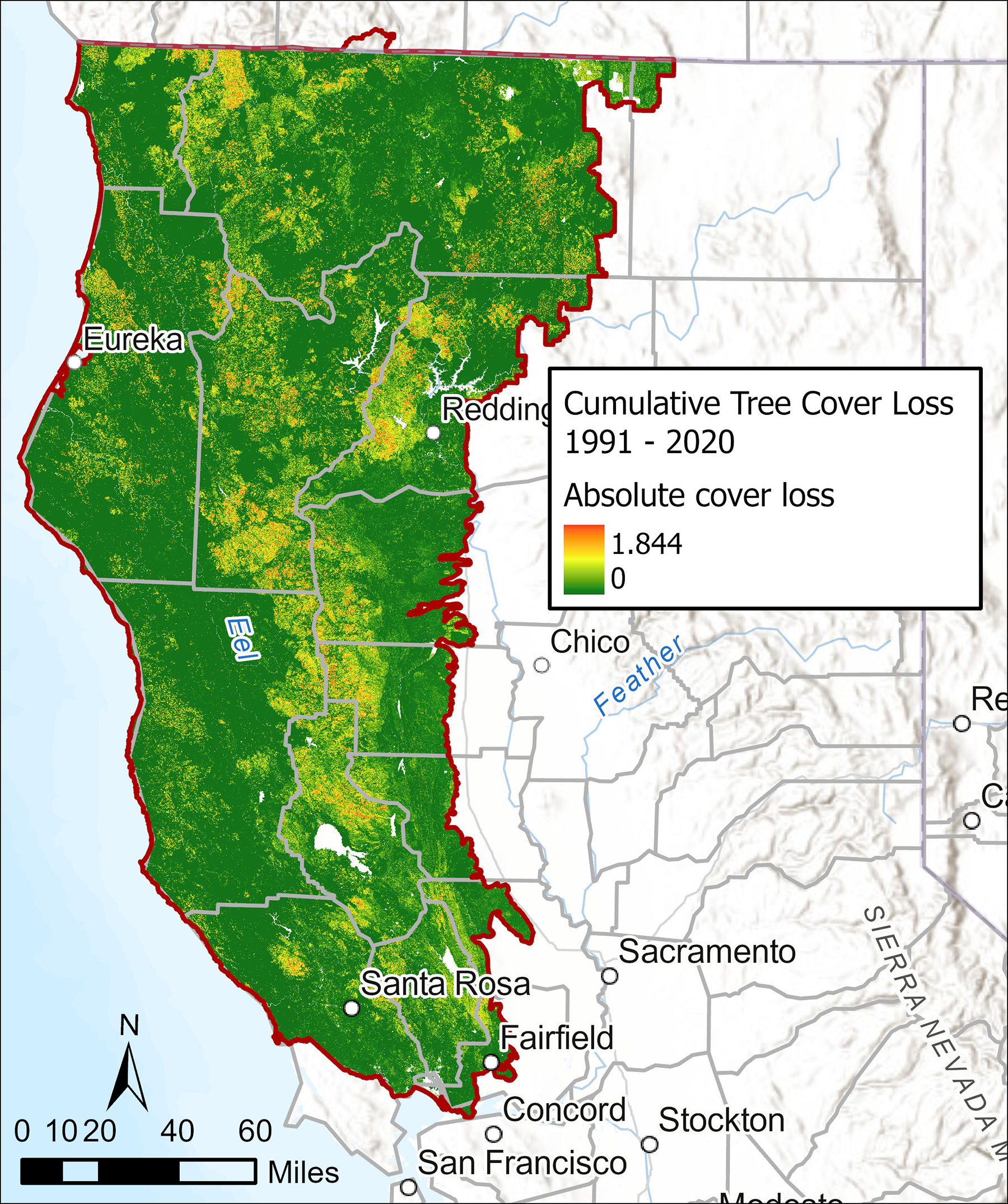Northern California Regional Profile
HEALTHY & RESILIENT FORESTS

photo credit: Bob Wick, Bureau of Land Management.
Overview
Forests and woodlands cover approximately 60% of the Northern California landscape and provide vital ecosystem services, including protecting the health of key water sources, sequestering and storing carbon, and offering recreational opportunities. Managers are challenged to respond to multiple threats to these ecosystems, including climate change, invasive species, novel pathogens, development of natural lands, and changing wildfire regimes. Threats and management priorities vary by forest type.
Coast Redwood Forests
Coast redwood forests are an iconic ecosystem of Northern California and have long played an integral role in the regional economies of timber and tourism for the North Coast counties. The coast redwood ecosystem exists in a narrow band from Monterey County in the Central Coast in the south to California’s border with Oregon in the north. This area is known as the fog belt, and these forests are only able to persist because of the critical summertime moisture provided by fog that sustains them through the dry summer season. Both redwood trees and many of the understory plants are specially adapted to absorb fog water through their leaves. If fog frequency declines in the future due to climate change, redwood forests may be increasingly drought stressed. A related concern is that thinning in some coast redwood forests could create forest structures that are too open, thereby diminishing the forest’s ability to capture moisture from fog.
Coast redwood trees are adapted to both low- and high-intensity fire. Their thick bark protects living tissue, and they have the capacity to resprout from their trunk even after wildfire consumes their crowns. Studies estimate that the natural fire regime in redwoods was every 25-30 years due to both lightning ignitions and cultural burning by Indigenous people. These trees can live for over 2,000 years and grow over 320 ft tall, making them the tallest trees in the world. However, few of these ancient trees still exist because redwood is one of the most valuable trees for timber.
The redwood ecosystem, including both the North Coast and the more southern range along the Central Coast, has experienced a long history of intensive logging. Of the 1.6 million acres of remaining coast redwood forest, 93% has been logged at least once, leaving relic old-growth patches scattered across a highly fragmented landscape. Visitors to the region typically experience redwood trees in state, national and regional parks, but 35% of redwood forests is managed by commercial timber companies, while an additional 37% is owned by small private landowners and also considered unprotected. This has resulted in a fragmented ecosystem under a mosaic of different ownerships, which complicates efforts to increase forest resilience to wildfire.
Historically, there has been little catastrophic fire in redwood forests, but this has started to change for the Northern California region in the last 15 years. Furthermore, the CZU Lightning Complex fire that burned across 86,509 acres of forest lands in the Central Coast in August 2020 at much higher severity than previously occurred has changed perception about how mature redwood forests could burn as a result of climate change and other changing disturbance regimes. One emerging threat is the prevalence of sudden oak death, an infectious disease caused by an exotic invasive water mold Phytophthora ramorum. Although coast redwood trees are not susceptible to the pathogen, they frequently co-occur with tanoak trees which have suffered as high as 90-100% mortality in some impacted areas. Dead tanoak trees alter fuel loads and can increase the risk of higher-severity fire because fire can move from the surface to the canopy by using the standing dead trees as a ladder.
Mixed Conifer Forests
Moving inland from the coast and to higher elevations, mixed conifer forests dominate the forested landscape, with notable tree species including Douglas-fir, tanoak, California bay laurel, Pacific madrone, and a variety of pine and oak species. Similar to the redwoods, these forests are adapted to frequent, low-severity fire. In the eastern Klamath ecoregion, forests evolved with a fire return interval of less than 25 years, and this interval could be significantly less in areas due to Indigenous land management.
Much of this forested land is now federally-managed, including four large national forests: Klamath, Mendocino, Six Rivers, and Shasta-Trinity. For most of the 20th century, federal forest management in this region was governed by principles of providing sustained timber yield. In 1994, the implementation of the Northwest Forest Plan (NWFP) shifted federal land management practices for 17 national forests, including the four in this region, in an effort to better protect public values that forests provide. A primary focus of the revised land management plan was protecting remaining old-growth forests and the endangered species, such as the northern spotted owl and marbled murrelet, which depend on this habitat, as well as protecting sensitive aquatic habitats. As a result, NWFP significantly restricted timber harvesting on federal lands in the region.
Although NWFP was highly effective in preventing clear-cutting of old-growth forest, biodiversity in these forests has continued to decline due to other threats. In particular, warming climate and denser forests due to the legacy of plantation-style timber management and fire suppression have led to both drought- and fire-driven tree mortality. Furthermore, the planned goal to maintain a viable timber industry to sustain rural communities and economies was not realized under the original plan. In July 2023, the U.S. Department of Agriculture appointed a new Federal Advisory Committee to provide recommendations on updating the NWFP to better respond to current management needs, including climate change and other novel disturbances. The plan will be updated to incorporate traditional ecological knowledge as well as the latest science. One planned revision is requiring a landscape-based approach that provides more flexibility for managing biodiversity conservation than the historic plan which emphasized strict habitat designations and single species management.
Another challenge facing regional forest management is tree mortality associated with drought and insect pest outbreaks. Similar to the Sierra Nevada region, there are species of pine, such as Ponderosa pine and sugar pine, in Northern California that are especially susceptible. Bark beetles, such as the mountain pine beetle and western pine beetle, naturally occur in the region and under normal conditions create smaller patches of tree mortality that benefit forest structure diversity. However, under the recent drought conditions and poor forest health, bark beetle populations have surged in many forests of California and led to widespread tree mortality. This mortality can result in larger and more severe wildfires due to increased dead fuels on the landscape. Forest stands that had previously been treated by prescribed fire and mechanical thinning have been found to experience lower mortality because fewer trees meant less competition for water resources. Additionally, research indicates that low-severity fire can spur sap production in surviving pines for a decade or more, bolstering defenses against bark beetles. Thus, forest treatments that reduce the probability of severe wildfire can also make forests more resilient to drought and bark beetle infestations.
There is a need for more monitoring and research to understand how to make redwood forests and mixed conifer forests in the region more resilient to fire because fire dynamics in these ecosystems are less-studied than, for example, forests in the Sierra Nevada region. Many stakeholders in the region are interested in improving forest health by restoring fire to the landscape through prescribed burning and cultural burning. However, in many areas fuels need to be reduced by other means first before it is considered safe or ecologically effective to do controlled burning. One concern is that forests in the coastal region are highly productive and regrowth happens quickly after vegetation treatments, which means that fuels reaccumulate quickly, too. In general though, there is consensus that encouraging the growth of larger trees and reducing forest density is important for making Northern California forests more fire-resistant.
Oak Woodlands
Oak woodlands are an ecologically and culturally important ecosystem that can be found in lower-elevation areas throughout the Northern California region. The distribution of oak species varies across the region. Commonly found oak species in the North Coast include Oregon white oak, canyon live oak and California black oak. In the northern interior region, there is a mixture of blue oak, California black oak, canyon live oak, and Oregon white oak. In the Sacramento region, as well as more southern areas of the Central Valley, there are significant valley oak and blue oak woodlands.
The majority of oak woodlands in the region are located on private property, which places this habitat at high risk of land development, especially in more urban areas such as the Sacramento region. For example, Napa County has already lost an estimated 90% of historic oak woodlands since the early 1880s. Oak woodlands are also vulnerable to habitat type conversion due to encroachment by Douglas-fir trees and invasive grasses, which is being largely driven by the suppression of the fire regimes to which oaks were adapted. Similarly to other regions of the state, Northern California oak woodlands are also threatened by emerging diseases. Sudden oak death has killed millions of tanoaks and oak trees in coastal California forests since the late 1990s. Recently, extreme drought has also killed many oak trees and is a heightening concern under climate change.
Tree mortality increases surface fuel loads and numbers of standing dead trees (snags) on the landscape. Management actions that restore low-severity fire back into these systems, reduce fuel loads, and remove invasive species will increase the resilience of oak woodlands to future climate change, invasive species, and novel pathogens. Organizations such as resource conservation districts are also leading efforts in the region to plant acorns and restore oak trees.
Stakeholder Perspectives

Survey respondents were asked how important various potential areas of investment were for achieving healthy and resilient forests in their area of Northern California. The vast majority of stakeholders rated reducing fuel loads as extremely important for achieving this objective. Other top priorities for investment were applying prescribed fire, adapting management for climate change, and increasing forest management workforce. Many other areas of investment were also considered to be on average at least moderately important. Developing a robust timber economy, developing wood products infrastructure, and developing biochar production capacity were considered on average to be less important. However, the related topic of developing economic solutions, such as new infrastructure and markets, to better deal with biomass from forest treatments was a topic commonly mentioned as a high priority during expert interviews.
Resource Conditions


The risk of trees dying during drought metric (top) is an index based on the ratio of local moisture balance and tree density. Low values can indicate minimal risk because moisture balance is sufficient to support the surrounding trees, or simply because there are few trees present. However, high values indicate significant risk of tree dieoff during a drought. Managers may use this metric to prioritize areas for thinning treatments, in the hopes that less competition for available water will reduce the risk of tree dieoff. In Northern California, risk of dieoff is significant along the Mendocino County coast, and much of the Shasta-Trinity National Forest. The Regional Resource Kit also includes data on cumulative tree cover loss (bottom) quantified by remote sensing and including loss resulting from all types of disturbances, including logging. This metric is measured as an absolute value, ranging from 0 to 1; though values can exceed 1 if multiple disturbances occurred. In Northern California, much of the tree cover loss is concentrated in a band running from northern Lake County to southern Trinity County, with additional areas of high tree cover loss in western Shasta and Siskiyou Counties.
